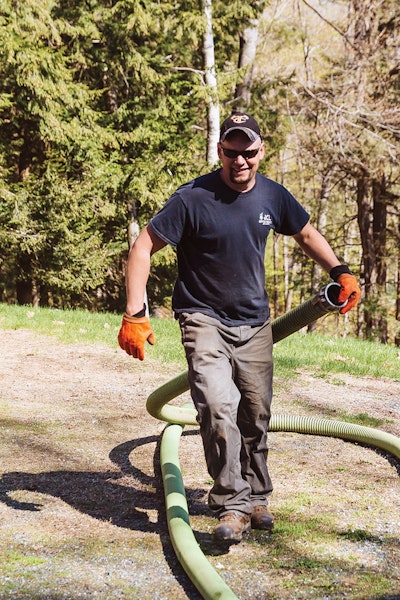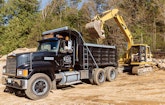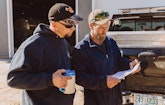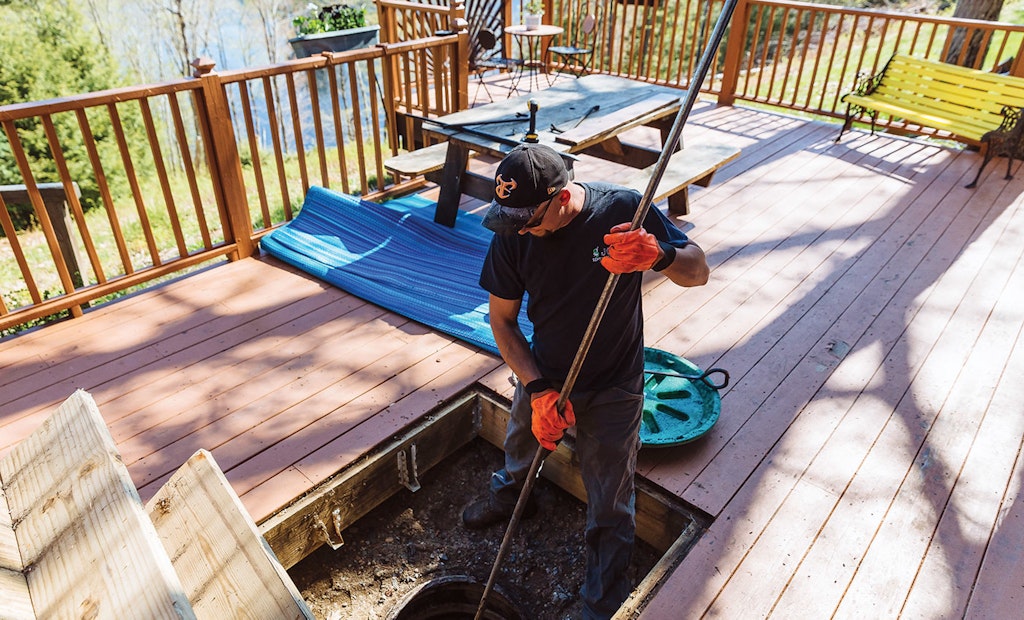Cory Lawrence has a pretty good idea why JCL Septic Service, the company he and Jon Charlonne founded in 2011, has been a big hit with customers: hands-on attention from the owners on every job.
“When we go out to a customer’s house, there is always one of the owners on site all the time, either me or Jon,” Lawrence says. “The customers really appreciate that.”
They created JCL in Bennington, New Hampshire, when they bought a small pumping company, Frank’s Septic Service. That company, basically a one-man operation, had one vacuum truck, plus a small dump truck and an aging skid-steer. JCL still uses the vacuum truck, but the other gear has been replaced with equipment more suitable to a company that performs septic system installations and other excavating work along with septic pumping.
From the beginning, there has been a clear division of labor at JCL. Lawrence handles the septic pumping work and Charlonne handles day-to-day operations, excavation work and the septic system installations. Lawrence generally works by himself. Charlonne works with a three-man crew — Mike Anderson, Charlie Johnson and Brian Wesolowski. The other member of the team is Ann Avery, who takes care of the office and the phones.
Even though the septic pumping company they bought didn’t have any excavating equipment, it was always part of the JCL plan to do excavating and septic installations.
“We were pretty much renting the equipment when we got the jobs,” Lawrence says. “Sometimes you rent the excavator for a week, sometimes for a month. It would be cheaper for a month. Now we have all the equipment, and we stay extremely busy.”
EQUIPMENT LIST
The fleet on the septic side of the business includes a 1979 Kenworth W900 truck that had been in storage for 30 years when JCL bought it. It has a 4,000-gallon Amthor International aluminum tank and a National Vacuum Equipment Challenger pump. The other pumping service rig is a 1995 Kenworth T400 with a 2,800-gallon aluminum tank (Progress Tank) and National Vacuum Equipment Challenger pump. That’s the one that came with the business when they bought it.
For the excavation and installation side of the business, equipment includes two Caterpillar 312 excavators, a Bobcat skid-steer, a Bobcat mini-excavator, a Caterpillar bulldozer and two Mack dump trucks with Bibeau 14-yard bodies.
They have managed to acquire the equipment without saddling the company with a lot of debt. “There’s a few things we’re still paying on, but 90 percent of it is paid for,” Lawrence says. “We got them for a good deal and we paid them right off.”
FRIENDS, THEN PARTNERS
Lawrence, 42, and Charlonne, 40, have known each other since childhood.
“We worked together at a couple different companies. We went our own separate ways for a little bit. Then we got offered an opportunity to buy a septic business and we thought it would be a good idea to jump in on it,” Lawrence explains. “We’d been talking about doing something together for years. The opportunity finally arrived, and we ran with it.”
Later, they brought in Avery to take care of the phones, run the computers and send out reminder notices to customers. That has been a boost to the company in several ways, Lawrence says, in addition to building on the volume of work the company can handle. Mobile phone technology may make it possible for an operator to handle phone calls while on a job site, but Lawrence doesn’t think it makes a good impression on customers.
“It takes up a lot of time if you have to answer the phone all the time,” he says. “It doesn’t look good for the customer either. They don’t want to pay you to stop working to answer the phone.”
JCL uses some of the standard marketing tools — phone book, website and social media — but Lawrence says word-of-mouth is still the source for a lot of their new business.
The company also uses the pumping division to market the installation division.
“Because I’m doing the septic pumping, if there is a problem with the septic, we’re already there,” Lawrence says. “We can tell the customer that we can do everything, so you don’t have to look around. We’re pretty much the first ones in.”
JCL also gives all its field workers uniforms — jeans and a sweatshirt with the company logo — and the company sends the pants out to get cleaned. Lawrence says it helps the company maintain a professional image, which they consider part of quality customer service.
They also make the effort to be pleasant. “We try to go to (a customer’s) house with a smile,” Lawrence says.
ON THE ROAD AGAIN
JCL serves a mostly rural area, and there aren’t many wastewater treatment plants where Lawrence can empty the truck. Some of the plants JCL uses are small and limited in how much quantity they can accept from septic haulers. That means the company must plan ahead to avoid having to drive farther than necessary with a full load.
“If we have somebody who needs their tank pumped in, say, Newport (to the north), we try to get a couple of them so I’m not driving 35 miles for just one tank, because then you’re not making any money,” Lawrence says.
JCL can deliver to wastewater treatment plants in nearby Antrim or in Jaffrey, 19 miles to the south, or in Concord, 30 miles to the east.
“Antrim and Jaffrey are very limited,” Lawrence says. “They can only take so many gallons a day there. When you have three or four different septic companies coming in to dispose, you’ve got to make sure you call ahead. It wouldn’t be very profitable to be over in Jaffrey pumping septic tanks and then have to take it all the way to Concord to get rid of it.”
Lawrence says the company considered building some onsite storage to reduce the number of trips to the treatment plants but decided that it would not be cost-effective.
He says that he tries to plan about a week ahead to be sure that he’ll be able to dispose of his loads without unnecessary driving. He does not use special logistics software.
“I just give them a call,” Lawrence says. “We look at our schedule and how many people have called in to have their tanks pumped. If I’m over in the Jaffrey area, that’s where I’ll dump. If I’m over in Hillsboro (to the north), I’ll go to the other plants.”
Even with good planning, Lawrence says he puts 100-300 miles a day on the truck, and he estimates 70 percent of the driving is traveling to a wastewater treatment plant. He often has to empty the truck two or three times in a day.
LONG HOURS
Lawrence says the company stays busy year-round. Sometimes JCL supplements its regular work with plowing or landscape work. He said in spring, summer, and fall, once the pumping comes in, that’s all he does.
“I try to do 8-10 tanks a day,” he says. “It means anywhere from eight to 12 hours a day. It’s good to be working that much, because if you’re not, you’re not making money. Jon and I are pretty much 7 days a week. Saturdays and Sundays it’s mostly for emergency calls.”
Lawrence says Charlonne and the excavation crew typically install 40-45 septic systems a year, about half of them conventional stone and pipe systems, using washed stone from a local quarry and Polylok HD lids and risers. The other half of their installations are Presby Environmental Inc. systems. Some installations utilize raised mounds due to sites with a high water table.
HARD WORK PAYS OFF
A willingness to work has been their key to success.
“We’ve come a long way in a short amount of time,” Lawrence says. “We basically didn’t have two nickels to rub together to start. It was pretty much our hands and hard work. That’s how we got here.”
Lawrence doesn’t expect to grow much in the near future.
“We kind of want to just keep it with the amount of people that we have. We don’t really want to get any bigger,” he says. “I might eventually have to hire someone else to run the other pump truck. I’m sure that’s going to start getting bigger as the years go by.”
But he doesn’t expect that to happen soon.
“Not for a while,” he says. “I’m not ready to jump into that yet. If I do need help, I’ll just pull one of the guys who are working for us now to help me.”
Retro truck makes an impression
A classic truck that looks good enough to enter in car and truck shows makes a splashy impression for a septic pumping company, but this refurbished 1979 Kenworth W900 is not just for show.
“I probably pumped 800,000 gallons with it last year, if not more,” says Cory Lawrence, co-owner of JCL Septic Service in Bennington, New Hampshire. That’s a lot of work for an old truck, especially one that stays in the garage for part of the year because he doesn’t want it exposed to the salt on the roads.
Lawrence and his partner, Jon Charlonne, bought the truck out of storage in 2016 and restored it. “It was in storage since 1985,” Lawrence says. “It had a few minor issues from just sitting, but nothing bad.”
The truck was originally used for crane transport. Lawrence and Charlonne installed an Amthor International tank and National Vacuum Equipment Challenger pump themselves. They also replaced many other parts that tend to deteriorate from lack of use.
The partners were looking for an older truck without modern emissions controls. “They are just easier to work on,” Lawrence says. “It has really low miles. It’s like a brand-new truck for being that old. That’s why we bought it.” And it looks nice — nice enough that Lawrence takes it to car shows sometimes.
It’s the truck Lawrence uses for 75 percent of the company’s pumping, going out in “spring, summer and fall in the good weather,” Lawrence says. “It’s clean. I don’t want to get the salt on it.”
The backup is a 1995 Kenworth with the 2,800-gallon tank. That truck still has the old company’s name, Frank’s Septic Service. That’s going to change pretty soon, Lawrence says.












